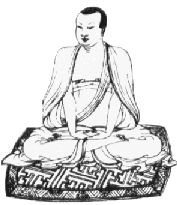![[Main ROKPA Homepage]](images/anilonew.gif)





Meditation Posture
|
 |
Mind and Body: the need for a good postureFrom the moment of conception until the moment of death, mind and body are inextricably linked. Were it possible to separate them (it isn't), one could say that they constantly affect each other. Most people understand that mind affects body, as they see examples of this all day long. The moment people come into a room, their posture tells us whether they are feeling good, depressed, self-confident, afraid, tense and so forth - long before they say a word. But few people realise just how much body and breath can be used to help the mind. As meditation is concerned with taming and awakening the mind, posture can be mobilised to great use. Although one can think, visualise, pray or do mental exercises in any position, there are few in which can remain healthily and comfortably for the time it takes to accomplish most meditations. The few that permit this (lying flat etc) often tend make one sleepy as the meditation brings relaxation. This is not what meditation is for. In a good meditation posture, relaxation becomes the basis for the crystal clarity of awakened awareness, not a sleepy haze. Although it may be hard for beginners to get
used to the classical Buddhist meditation postures, the rewards
of a few sessions with aching knees are tremendous, as one can
meditate in that good position for the rest of one's life. Correct
posture helps the mind find peace, strenght and control. It benefits
the physical body by bringing its energies and bio-systems into
balance. And one can spend all day in a clasical posture in a
state of great harmony - virtually impossible in everyday positions.
Below you will find the classical 7-Point Posture of Vairocana,
with some variations. |
|
The 7-Point Posture of Vairocana1. The back (i.e. from nape of neck to the small of the back) should be made as straight as possible - like an arrow or like a pile of coins. 2. The legs should be crossed in the vajra or bodhisattva posture (see right). 3. The hands (see below) should be folded, 4 fingers' width below the navel (not resting on the feet), the elbows slightly out. The shoulders are held up and back ('like a vulture') 4. The chin should be tucked in slightly, 'like an iron hook'. 5. The eyes (see below) should be relaxedly looking into space, at nothing in particular, somewhere about 16 fingers width in front of the nose. 6. The tongue should be held against the upper palate. 7. The lips should be slightly apart, the teeth not clenched. One breaths through the nose. top of page |
|
Eyes and Gaze |
 |
Although beginners tend to find it easier to meditate with eyes closed, it is better to train oneself to meditate with open eyes from the outset. Closed eyes favour thoughts, daydreaming and distraction. Furthermore, one does not get into the habit of meditating while being visually conscious, meditation becomes associated with an 'other', inner world rather than a clearer, truer way of seeing this world.
Visual consciousness is one of the strongest factors in most people's lives. In order to understand it and bring it under control, there are many ways of using the eyes and the gaze while meditating. These need to be applied at the right time, in the right way, under the guidance of a competent meditation teacher. In the classical Vairocana posture the eyes are open but not looking at anything in particular, just resting relaxedly on a spot somewhere about 16 fingers' breadth in front of the nose. Sometimes, in this posture, they look at the tip of the nose, or just 4 fingers' breadth in front of it. The main point of this is twofold: to overcome the power of habitual visual distractions and to free the mind from the dominating power of visual consciousness. With time, it will be replaced by the inner eye of mind's wisdom.
Relaxation is important, so one should not stare fixedly or tensely and it is alright to blink so as to irrigate the eyes. If visual tension is building up (dancing colours and optical effects due to maintaining a fixed gaze), one can slowly and calmly shift the gaze to nearby objects and/or close the eyes for a while. top of page


